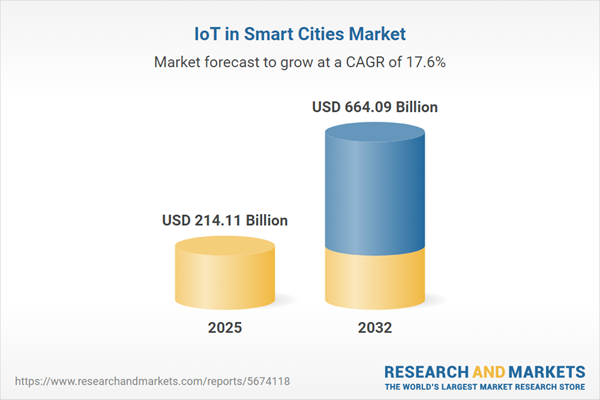Speak directly to the analyst to clarify any post sales queries you may have.
Senior leaders recognize Internet of Things (IoT) solutions as a core enabler of smart city transformation, driving operational improvements, enhanced sustainability, and resilient urban services through real-time data integration and strategic technology deployment.
Market Snapshot: IoT in Smart Cities Market Size and Trends
The global IoT in smart cities market is estimated at USD 182.07 billion in 2024, with projections to reach USD 214.11 billion by 2025. By 2032, the market is expected to accelerate to USD 664.09 billion, supported by a robust 17.55% CAGR. Sustained investment in digital infrastructure and advanced analytics solutions continues to propel urban modernization. City authorities are advancing the capabilities of urban systems to address transportation, safety, and service provision challenges. Public-private partnerships are intensifying, pushing for new technological innovation. The maturity of IoT platforms is enabling more versatile deployment, helping a range of cities adapt to increasing complexity and shifting resident demands.
Scope & Segmentation of IoT in Smart Cities
- Components: Advanced sensors, resilient gateways, and responsive actuators form the essential backbone for citywide digital ecosystems, enabling continuous data capture and smart automation across municipal networks.
- Service Providers: Vendors deliver end-to-end services encompassing system installation, tailored customization, and ongoing operations and maintenance, aligning with municipal objectives for reliability and performance.
- Communication Technology: Solutions leverage a comprehensive portfolio—such as 5G, LTE, LoRaWAN, NB-IoT, Sigfox, Bluetooth, and Wi-Fi—supporting secure, real-time connectivity for interdepartmental collaboration and process automation.
- Applications: IoT platforms enable a spectrum of urban use cases, from traffic and energy management to automated lighting, waste collection optimization, and public safety. This breadth supports environmental goals and elevates resident experience.
- End Use: City governments, utility providers, transportation networks, and health organizations collaborate via IoT platforms to meet compliance needs, enhance efficiency, and drive higher-quality public service delivery.
- Deployment Mode: Cloud-based models and on-premise solutions allow flexible scaling and ensure that deployment addresses regulatory priorities and changing infrastructure needs.
- Regional Coverage: Adoption varies across the Americas, Europe, Middle East and Africa, and Asia-Pacific, reflecting unique local policies, funding dynamics, and existing infrastructure maturity. Targeted regional investment and supportive regulatory environments influence the pace of implementation and innovation.
- Key Companies Analyzed: Cisco Systems, IBM Corporation, Huawei Technologies, Actility, Schneider Electric, Trigyn Technologies, SAP SE, Microsoft, Qualcomm, Hitachi, and TEKTELIC Communications provide strategic benchmarks for selecting solutions and forming impactful partnerships in the sector.
Key Takeaways for Senior Leaders
- Urban managers can leverage evolving digital infrastructure to address sustainability and operational targets more effectively as IoT ecosystems mature and diversify.
- Integrating centralized analytics tools empowers leaders with actionable intelligence, enabling more strategic resource planning and improved interdepartmental cooperation.
- Strong partnerships between public agencies and technology providers play a crucial role in minimizing operational silos and fostering citywide modernization initiatives.
- Focused investment in data governance and cybersecurity remains essential for meeting regulatory standards and building long-term public trust.
- Aligning procurement with regional regulations facilitates smoother implementations and strengthens collaboration with technology vendors.
Tariff Impact: Navigating the U.S. 2025 Regulatory Shift
The approaching U.S. tariffs on smart city hardware have prompted organizations to refine procurement and pricing strategies at municipal and national levels. Entities are aligning their service offerings to comply with changing regulatory requirements. This shift also encourages domestic innovation, supporting IoT network configurations that address specific local conditions and stakeholder priorities.
Methodology & Data Sources
Key insights are drawn from expert interviews with city administrators and technology professionals, further reinforced by recent academic and policy studies. Quantitative market analysis is validated with real-world case studies, ensuring each recommendation is actionable for leaders managing complex urban transformations.
Why This Report Matters to Smart City Decision Makers
- Delivers a standards-based roadmap for strategic IoT deployment, ensuring digital infrastructure investments translate into tangible improvements citywide.
- Guides portfolio prioritization and resource management to maximize operational impact and support sustainability initiatives for growing urban communities.
- Enables scenario-based planning aligned with wider policy frameworks, future-proofing city services and infrastructure investments against emerging challenges.
Conclusion
This report equips senior decision-makers to lead urban innovation, strengthening infrastructure and deploying targeted IoT solutions to enhance city adaptability and operational effectiveness.
Additional Product Information:
- Purchase of this report includes 1 year online access with quarterly updates.
- This report can be updated on request. Please contact our Customer Experience team using the Ask a Question widget on our website.
Table of Contents
3. Executive Summary
4. Market Overview
7. Cumulative Impact of Artificial Intelligence 2025
Companies Mentioned
The companies profiled in this IoT in Smart Cities market report include:- Cisco Systems, Inc.
- IBM Corporation
- Huawei Technologies Co., Ltd.
- Actility
- Schneider Electric SE
- Trigyn Technologies Limited
- SAP SE
- Microsoft Corporation
- Qualcomm Incorporated
- Hitachi, Ltd.
- TEKTELIC Communications Inc.
Table Information
| Report Attribute | Details |
|---|---|
| No. of Pages | 192 |
| Published | November 2025 |
| Forecast Period | 2025 - 2032 |
| Estimated Market Value ( USD | $ 214.11 Billion |
| Forecasted Market Value ( USD | $ 664.09 Billion |
| Compound Annual Growth Rate | 17.5% |
| Regions Covered | Global |
| No. of Companies Mentioned | 12 |









